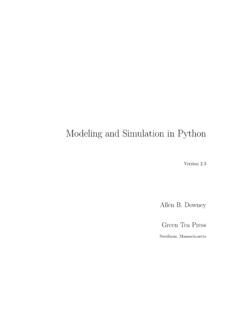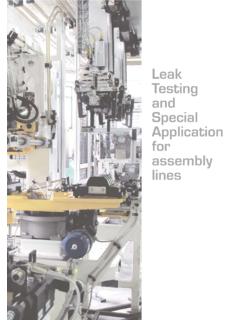Transcription of Operational Readiness - Is Your System More 'Ready' Than ...
1 Reprinted from Project Management Institute Inc., First to the Future: Proceedings of the 32nd Annual Seminars & Symposium, Nashville, TN (2001). All rights reserved. Unauthorized reproduction of this material is strictly prohibited. Operational Readiness Is your System More Ready . Than your Environment? Donald G. Gardner, President, Gardner Project Integration Group, Ltd. Introduction money and resources were burned. On the other hand, this was a loss that some felt could have been avoided. A story Could any of these issues and their associated risks have been It seemed as if the project would be a slam-dunk. The new re- forecasted? Sometimes a project takes on a speed and life of its placement System would do the work of the three systems currently own and turning back seems no longer an option. More likely, in operation (and help us decommission the old systems). The the team was focused on the project end state and did not con- users developed a rigorous Requirements Document, a vendor was sider the view, on the ground.
2 Importantly, the team did not con- selected from a field of candidates, the contract was executed, sider the Readiness of the end-user community or the and the project team was formed and created its project plan. All organizational feasibility to make the requisite change to the seemed to be in place to move ahead. What the team did not see status quo. was the string of land mines that had been placed in its path. How often have we heard that the project is ready to imple- The mines included broad issues like a pending corporatewide ment? Systems are all checked, user acceptance complete, pro- merger that would render the proposed configuration less than duction environment is ready to roll! But the project somehow appropriate in the newly merged environment. Core gaps in fails to implement as expected. The users did not seem to un- functionality that were acceptable before the merger would ul- derstand the new capabilities. The bandwidth was nowhere near timately impact anticipated efficiency gains, post merger.
3 Perhaps what it was supposed to be. Roles and responsibilities had not the most serious land mine of all was the end-user operations been established. Workflows were not thought through. The group simply did not want the new System . stories are all too familiar. In the end, the recommendation to terminate the project was So why didn't it work? What are we leaving out? For all their so- made by the project sponsor and accepted. It was not a pretty pic- phisticated project structures and discipline, many project ture. A lot of money was lost; resources were consumed that methodologies today lack a critical planning component a built- could have been applied elsewhere; expectations were raised in Readiness assessment process. Just how ready is the environment and then eliminated; and reputations were impacted. On one for the new System , product, or process the project is about to hand, it was better to stop a doomed project before even more bring?
4 Preparing for Readiness is not something done just prior to Exhibit 1. Proceedings of the Project Management Institute Annual Seminars & Symposium November 1 10, 2001 Nashville,Tenn., USA. Exhibit 2. turning the key to open the door. This process needs to be activated If all this seems pretty obvious, it apparently is not. If it were earlier in the project and it needs to be rigorous. Readiness must so, wouldn't all our projects be implemented more efficiently? be woven into the project fabric and developed even as the proj- Why are they not successful? We have heard about how our proj- ect requirements and specifications are being created. ects are failing in the up-front planning process because of Readying the environment means looking well beyond the sys- poor requirements and user support. They are also failing at the tem, product, or process (the entity ) the project will create and end point acceptance testing brings too many issues to the sur- looking to the world in which these will function.
5 The original face that should have been resolved in the requirements or de- project vision or business case rarely asks for a specific kind of sign phases. Desired functionality is not in place. The System (unless of course we are discussing a new operating sys- end-to-end testing is System focused and does not consider tem or systems platform or something of that sort). Typically, the changes in workflow. End users are not fully informed of the business case that is developed to launch a new project is pre- changes about to occur in their world. Roles and responsibili- sented at a more strategic level. It envisions how a new product, ties have not been established or communicated. These com- a new processing facility or a redesigned workflow will grow mar- ponents can signal a substantial risk to project success if no ket share or revenues, or how it will reduce operating expenses. corrective actions are taken. This is particularly applicable to Systems can be part of the equation, but they are not the only projects in financial services institutions, which have a global component.
6 Reach. To really be successful with our implementations, we must view Operational Readiness significantly enhances the chance for the project delivery from a broader perspective. Are the people project success by preparing the end-user environment, not as an ready? Are their skills at the level they need to be to operate this new afterthought, but as an integral part of project management. The entity? Does the local management team support the changes concept of Readiness embraces five of the nine PMBOK Guide being brought by the project? Have they prepared their people? Do Knowledge Areas Scope, Time, Cost, Quality, and Risk. they want to make this change? Will the facilities support the de- This paper will explore the key elements of an effective readi- mands of the new operating environment? Are proper continuity ness program and then return to another story to examine of business and contingency plans in place? What about the cul- how proper application of the program can mean success for tural aspects?
7 In short, is the environment ready to change? a project. Proceedings of the Project Management Institute Annual Seminars & Symposium November 1 10, 2001 Nashville,Tenn., USA. Exhibit 3. Background and Fundamentals is fully formed and can be clearly presented as the end-user com- munity prepares for implementation. In this way, deficiencies in the Operational Readiness is a state that is moved toward incre- project deliverables can be quickly addressed and retested prior to mentally by performing tasks and creating deliverables through- actual implementation as part of the overall testing strategy. out the Project Life Cycle. An Operational Readiness Assessment In the Post-Implementation phase, after all Operational ad- ensures the operating environment is prepared to effectively justments are complete. Changes are assessed to determine support and accept the changes resulting from the project. The whether they met expectations. assessment helps determine the Readiness state of the receive The Readiness assessment illustrates where the operating en- organization and defines how close this environment is to the de- vironment is and is not prepared for pending project imple- sired Readiness state.
8 Mentation. If performed properly, the people who will ultimately The project manager and project team must develop the readi- own the new System or operating environment become propo- ness program and perform the assessments. These are necessary nents of the change, prepared to support the implementation deliverables for any project that develops new or enhanced prod- and, as a result, they will use the new entity more efficiently. ucts, processes, or systems. Results of the assessment carry greater significance for those Operational Readiness should be assessed and reassessed projects that require ongoing or iterative implementation phases. throughout the life of a project: Where the end state is created through multiple implementation During project initiation where strategies for delivery can be stages, lessons that are learned from the first assessment are related to the status quo. The end state vision is first introduced more easily applied to these subsequent stages.
9 To key stakeholders. In the Requirements/Definition phase, after requirements and functional specifications are approved. The team knows how the Key Elements of an Assessment end state will look on paper. Requirements and specifications can be reviewed with the users to test feasibility and reasonability. Baseline In the Design phase, after the product, process, or System and its infrastructure are designed. The resultant blueprint can be The assessment starts with a baseline condition for each di- tested with the end users to ensure a proper fit with the cur- mension of the Operational environment that will be affected by rent environment. the implementation process. This is applicable regardless of Toward the end of the Build/Test phase, Readiness is checked as the project phase in which the assessment is performed. The op- the project moves through its final testing cycles. The end product erational processes, structure, culture, and infrastructure are all Proceedings of the Project Management Institute Annual Seminars & Symposium November 1 10, 2001 Nashville,Tenn.
10 , USA. Exhibit 4. Phase 1 Phase 2 Phase 3 Phase 4 Phase 5 Phase 6. Business Post- Project Design Build /. Implementation Requirements / Implementation Initiation Analysis Test Identify key areas Assess current Test for Readiness Train staff and Make adjustments Define of change and state and Operational in the operating clients; to the production their potential develop plan needs, assess environment, approve and environment;. impacts to ensure Readiness and make adjustments deploy transfer Readiness of all prepare test where required production responsibility for dimensions and prepare the environment Continuous plans end user for Improvement to implementation the operating managers included as dimensions being assessed. Other dimensions can the users. For this reason, project managers conduct on-the- include: ground assessments as close to implementation as possible. It Functional relationships should be remembered, however that sufficient time must be left Staff skills and experience in the schedule to apply any changes that emerge from the as- Budget/financials sessment.



